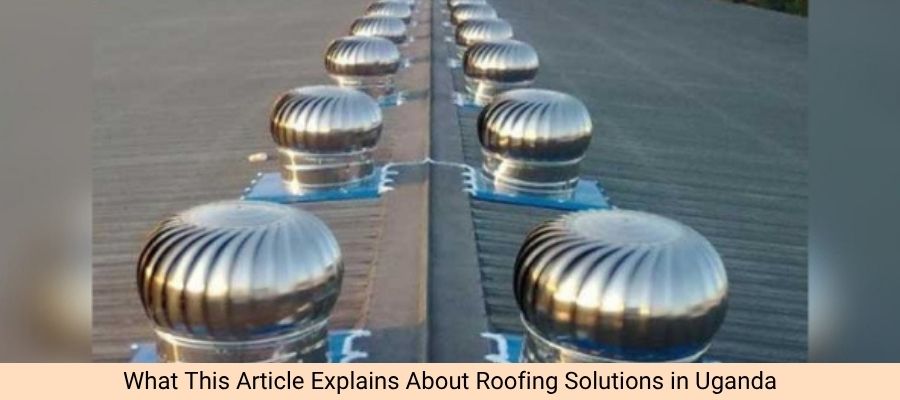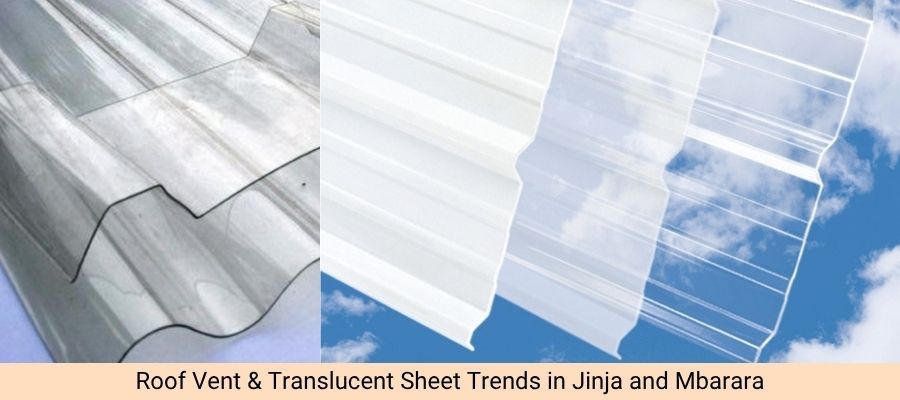Combining Roof Vents and Translucent Sheets for Better Airflow and Natural Lighting in Uganda Cities

Objective:
This article aims to explore the benefits and growing use of combining roof vents and translucent roofing sheets in urban Uganda. The objective is to demonstrate how this combination improves indoor airflow, reduces reliance on artificial lighting, and enhances energy efficiency, making it ideal for Uganda’s climate and urban settings. The article focuses on how different cities, including Kampala, Entebbe, Jinja, Mbarara, Gulu, Mbale, Fort Portal, Lira, Arua, and Masaka, are adopting this strategy and the role of manufacturers, suppliers, and contractors in implementing these systems.
Why Roof Vents + Translucent Sheets Matter in Uganda
In Uganda’s tropical climate, two critical issues are heat accumulation and inadequate natural lighting. Without proper ventilation, warm air trapped under roofs leads to discomfort and increased reliance on mechanical cooling. Additionally, buildings with opaque roofs or limited access to natural light often require more artificial lighting, increasing energy costs. Combining roof vents and translucent sheets addresses these challenges effectively.
Roof vents, such as ridge and turbine vents, expel hot air, while translucent roofing sheets allow natural light to penetrate without overheating spaces. This combination creates healthier, more comfortable indoor environments with lower energy consumption.
City by City Exploration of How the Strategy is Applied
Kampala – Urban High-Rise Elegance
In Kampala, the capital city and commercial hub of Uganda, the adoption of roof vents and translucent sheets is growing in high-rise buildings, commercial structures, and warehouses. These systems are particularly popular in buildings where both natural ventilation and daylighting are crucial to energy efficiency. Steel fabricators and contractors in Kampala have started integrating translucent roof sections, particularly in warehouses, to reduce artificial lighting loads. Roof vents are installed to allow hot air to escape, which is essential in maintaining comfortable indoor temperatures.
Entebbe – Waterfront Homes and Resort-Style Buildings
Entebbe, known for its lakeside properties and tourism resorts, benefits from the installation of translucent roofing sheets and roof vents in several waterfront homes and resort-style buildings. The natural light provided by translucent sheets enhances the airy, spacious feel of these buildings, while roof vents expel humid air from the lake. This combination helps maintain a comfortable indoor climate despite the high humidity typical of the region, promoting sustainable living and minimizing reliance on air conditioning systems.

Jinja – Commercial Buildings and Industrial Aesthetic
In Jinja, which is experiencing growth in commercial and industrial sectors, roof vents and translucent sheets are being incorporated into office buildings, industrial facilities, and shopping centers. The translucent sheets are used primarily for skylights and warehouse roofing to allow daylight into workspaces, reducing the need for artificial lighting. Roof vents in these spaces ensure proper ventilation, which is critical in high-traffic areas where air quality can be compromised.
Mbarara – Real Estate Growth and Mixed-Use Developments
Mbarara, a city seeing a rapid rise in real estate projects, has started integrating translucent roofing sheets and roof vents in residential homes and mixed-use buildings. The strategy is often used in common areas like lobbies, hallways, and garages, where natural light and good ventilation contribute to energy savings. Contractors in Mbarara recommend using modular roof vent systems combined with translucent sheets for quick installations and long-term benefits.
Gulu – Residential and Institutional Buildings
In Gulu, where both residential and institutional buildings are on the rise, combining roof vents and translucent sheets is becoming a popular choice in schools, offices, and residential buildings. These systems improve the indoor environment by allowing natural daylight into classrooms and meeting rooms, while roof vents help with airflow and moisture control. This combination helps keep buildings cool and comfortable without relying heavily on air conditioning.
Mbale – Hotels, Apartments, and Urban Growth
As Mbale expands, the use of roof vents and translucent sheets in hotels, apartments, and commercial buildings has increased. The hotel industry in Mbale relies on these systems to keep guest areas well-lit and comfortable. Translucent sheets provide daylight, while roof vents ensure fresh air circulation, reducing the need for mechanical cooling. This combination is particularly beneficial in the hospitality sector, where energy efficiency and guest comfort are priorities.
Fort Portal – Premium Residences and Tourism
In Fort Portal, a city known for its eco-tourism and luxury residences, the combination of roof vents and translucent sheets is being utilized to enhance both aesthetic appeal and energy efficiency. Translucent sheets are installed in skylights and atriums of tourist lodges and luxury homes to allow ample daylight, while roof vents help expel warm air and humidity from indoor spaces. This strategy helps create comfortable environments while adhering to the sustainable building practices preferred in the region.
Lira – Industrial and Residential Hybrid Zones
Lira, with its industrial and residential growth, benefits from the integration of roof vents and translucent roofing sheets in factories and modern homes. The strategy works well in both industrial and residential applications, where ventilation is crucial to maintaining comfortable indoor environments, especially in warehouses and multi-level homes. Roof vents help with temperature regulation, while translucent sheets brighten interior spaces without the added expense of electric lighting.
Arua – Infrastructure Boom and Remote Projects
Arua, known for its growing infrastructure and development projects, is adopting translucent roofing sheets and roof vents for buildings in remote areas. Prefabricated translucent sheets are often used in warehouses, schools, and public spaces to allow natural light to penetrate, while roof vents ensure proper airflow in buildings located far from power grids, reducing dependence on artificial lighting and ventilation systems. The combination is ideal for remote construction sites in Arua, where efficient and sustainable solutions are required.
Masaka – Modern Homes and Affordable Living
In Masaka, homeowners are increasingly choosing roof vents and translucent sheets for modern homes. Translucent sheets allow natural light to flood living rooms and outdoor terraces, creating bright, airy spaces. Roof vents ensure that any hot air or moisture trapped in the roof spaces is released, making homes more comfortable and energy-efficient. For affordable housing projects, this combination is cost-effective, providing both energy savings and natural cooling.
Benefits of Combining Roof Vents and Translucent Sheets
- Energy Efficiency: By allowing natural light into buildings, translucent sheets reduce the need for artificial lighting. Roof vents improve ventilation, reducing the need for air conditioning.
- Improved Indoor Comfort: The combined effect of natural light and airflow helps maintain a comfortable indoor temperature and air quality, especially in Uganda’s warm and humid climate.
- Sustainability: Both roof vents and translucent sheets are low-maintenance and environmentally friendly, contributing to sustainable building practices.
- Reduced Costs: By reducing the reliance on artificial lighting and cooling systems, these systems help cut down on energy costs in both residential and commercial buildings.
FAQs
Roof vents allow hot air to escape from the roof space, improving airflow and reducing the buildup of heat inside the building. This is particularly useful in Uganda’s warm climate, where proper ventilation can significantly improve indoor comfort.
Translucent roofing sheets allow natural daylight into buildings, reducing the need for artificial lighting. They also help with temperature regulation by letting in light without significant heat gain, making buildings more energy-efficient.
Yes, they are particularly beneficial in industrial buildings where ventilation and daylighting are important. Roof vents ensure air circulation and temperature control, while translucent sheets brighten workspaces and reduce the need for electrical lighting.
Yes, combining roof vents and translucent sheets works well in residential buildings, particularly in modern homes and multi-storey apartments, to improve comfort, aesthetics, and energy savings.
These systems use natural resources—sunlight and wind—to enhance the building environment, reducing the need for artificial lighting and cooling, leading to lower energy consumption and contributing to more sustainable building practices.
Polycarbonate and fibreglass are the most suitable materials for translucent sheets in Uganda’s tropical climate. They are UV-resistant, durable, and weatherproof, ideal for areas with high humidity and sunlight.
Conclusion
The combination of roof vents and translucent roofing sheets is proving to be a highly effective solution for improving airflow and natural lighting in Uganda’s growing cities. Whether in Kampala’s commercial buildings, Entebbe’s waterfront homes, or Masaka’s modern homes, this strategy enhances indoor comfort, reduces energy costs, and supports sustainable building practices. As Uganda continues to urbanize, this approach will remain a key element of eco-friendly, cost-effective, and modern architecture.

Founder & CEO
Mukesh Patel is the Founder & CEO of Build Matt ltd, specializing in Pre-Engineered Buildings (PEB) and general steel fabrication. With advanced technology, modern machinery, and a skilled workforce, he delivers efficient and high-quality solutions across East and Central Africa, including Uganda, Kenya, Tanzania, Congo, South Sudan, Rwanda, and Burundi.
- CNC Plasma Cut Decorative Metal Panels: Revolutionizing Interior and Exterior Design
- Combining Roof Vents and Translucent Sheets for Better Airflow and Natural Lighting in Uganda Cities
- Top Design Trends in Steel Staircases for Modern Ugandan Buildings
- Steel Railings & Balustrades for Uganda Cities
- Modern Steel Silos & Hoppers : Transforming Grain Storage Efficiency in Uganda






